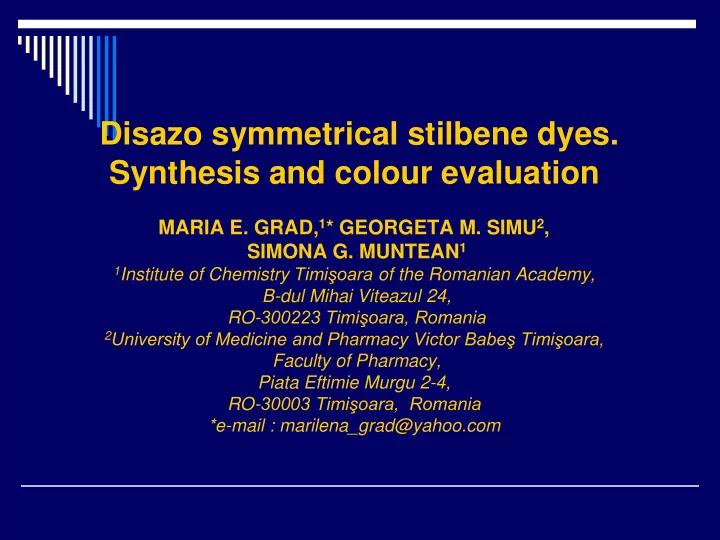

Disazo symmetrical stilbene dyes. Synthesis and colour evaluation MARIA E. GRAD, 1 * GEORGETA M. SIMU 2 , SIMONA G. MUNTEAN 1 1 Institute of Chemistry Timişoara of the Romanian Academy, B-dul Mihai Viteazul 24, RO- 300223 Timişoara, Romania 2 University of Medicine and Pharmacy Victor Babeş Timişoara, Faculty of Pharmacy, Piata Eftimie Murgu 2-4, RO- 30003 Timişoara, Romania *e-mail : marilena_grad@yahoo.com
AIM The synthesis of two new symmetrical disazo direct dyes containing 4,4'-diaminostilbene-2,2'disulphonic acid as middle component and 3-chlorosalicylanilide and 4-chlorosalicylanilide as coupling components The synthesized dyes were analyzed by thin layer chromatography (TLC), VIS, FT/IR and 13 C-NMR spectroscopy, and HPLC technique. The synthesized dyes were analyzed by means of the CIELAB parameters under the CIE recommended conditions: D65 /10 ° , A /10 ° , F2/10 ° The colour difference (ΔEab*) was calculated against one white standard (P.W.6; C.I.77 .891)
3 4 CH CH N N Ar Ar N N 1 2 5 6 7 SO 3 H HO 3 S where the couplings components Ar for the azo-stilbene dyes are;1 (for dye I); 2 (for dye II); 2' 3' 2' 3' 4' OH 1' 4' OH 1' 9' 10' 9' 10' 6' 5' 8' 6' 5' 8' CONH 11' CONH Cl 7' 11' 7' 13' 12' Cl 1 2 Scheme 1 Structures of the azo-stilbene dyes I and II (the atoms position for 13 C – NMR spectrum)
13 C-NMR rspectrum for the dye I (detail)
Jasco,C18, 83% aqueous MeOH Isocratic elution 25000 20000 semnal detector (471 nm) 15000 10000 5000 0 0 2 4 6 8 10 12 timp de retentie (min) Chromatogram for dye II
Colour measurements for the dye I compared to the white standard
Colour measurements for the dye II compared tot the white standard
The reflectance curve of the azo-stilbene dye I (2% dye concentration, D65 illuminant, 10 ° observer)
The reflectance curve of the azo-stilbene dye II (15% dye concentration, A illuminant, 10 ° observer)
CONCLUSIONS Two new disazo symmetrical direct dyes containing 4,4’ -diaminostilbene-2,2'-disulphonic acid as middle component and 3-chlorosalicylanilide and 4-chlorosalicylanilide as coupling components were synthesized and characterized. The spectroscopy data (VIS, FT/IR, 13 C-NMR), the chromatographic data (TLC and HPLC) and the colour analysis data (CIELAB) confirm the proposed chemical structures for the synthesized dyes. The colour differences (ΔEab*) calculated against one standard reveal a good colouring power of the studied dyes
Recommend
More recommend